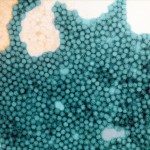Link to Pubmed [PMID] – 2193293
Oncogene 1990 Jun;5(6):857-65
In both experimental and spontaneous tumors, c-myc expression is often enhanced following its amplification or its rearrangement adjacent to a strong promotor/enhancer. However, c-myc by itself does not induce foci efficiently in fibroblast cultures. The effect of high levels of c-myc expression from a retroviral construct was investigated in several rodent fibroblast cell lines grown in medium containing 10% fetal calf serum or in serum-free PC-1 medium. c-myc-infected NIH3T3 clone 7 cells exhibited efficient quantitative focus formation when grown in PC-1 medium, whereas foci were not detected when grown in serum-supplemented medium. NIH3T3 clone 7 was the only cell line found to be sensitive to c-myc; other clones of NIH3T3 or other rodent fibroblast cell lines proved to be resistant to c-myc focus formation. At least two major types of morphologically distinct c-myc-induced foci were observed; the first was similar to ras-transformed foci induced in NIH3T3 and other fibroblast cell lines, and the second type was composed of adipocyte-like cells similar to NIH3T3 L1 cells. The c-myc infected cells cloned from these two types of foci expressed high levels of retrovirus-derived c-myc RNA and exhibited elevated levels of immunoreactive myc protein, as detected by immunofluorescent staining with an anti-myc polyclonal antibody. c-myc-transformed clones displayed only a limited ability to grow in soft-agar in the presence of serum and were not tumorigenic in nude mice. Focus formation by c-myc was quantitatively inhibited by the addition of interferon alpha + beta (INF alpha, beta), tumor necrosis factor alpha (TNF alpha) or transforming growth factor beta 1 (TGF beta 1) to the serum-free PC-1 medium, and, in correlation, NIH3T3 clone 7 cells produced the lowest level of endogenous TGF beta of the various cell lines tested.

